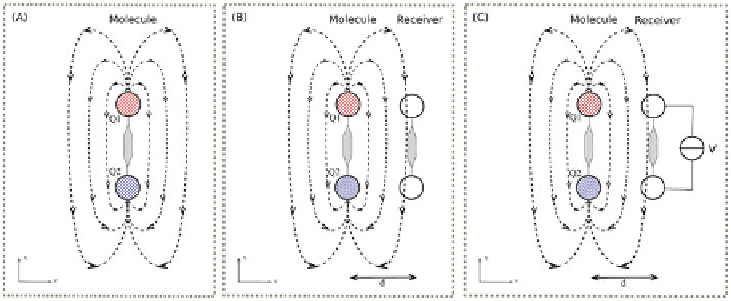Information Technology Reference
In-Depth Information
E
x
(
x, y, z
)=
N
E
xi
(
x, y, z
)
(7)
i
=1
E
y
(
x, y, z
)=
N
E
yi
(
x, y, z
)
(8)
i
=1
E
z
(
x, y, z
)=
N
E
zi
(
x, y, z
)
.
(9)
i
=1
Following this procedure, once the aggregated charges of the molecule in a
specific condition is obtained, it is possible to compute the electric field generated
by this system of charges (Fig.
17
(A)) at any point in the space surrounding the
molecule. Just as depicted in Fig.
17
(B), the electric field is “measured” putting
an ideal receiver nearby the molecule at the ideal distance from it to form a
squared cell. In order to get the measurement of the electric field, it is necessary
to define a new quantity called
equivalent voltage at the receiver
(see Fig.
17
(C)).
In particular, the equivalent voltage at the receiver could be computed by consid-
ering the component of the electric field parallel to the molecule and integrating
it along the width of the molecule.
Fig. 17.
Definition of the generated electric field and the equivalent voltage at the
receiver.
S II-C - How to Simulate a Molecular Wire.
After characterizing the
single bis-ferrocene molecule as QCA device, it is important to simulate a mole-
cular QCA wire made of oxidized bis-ferrocene molecules. To do this, an iterative
method could be adopted as sketched in Fig.
18
. In particular, the write-in sys-
tem is applied simulating the input molecule (Molecule 1 in Fig.
18
(A)) under
the effect of an electric field (also named switching field). Thus, the logic state
of the first molecule is given by the charge distribution and the dot charges are

Search WWH ::

Custom Search